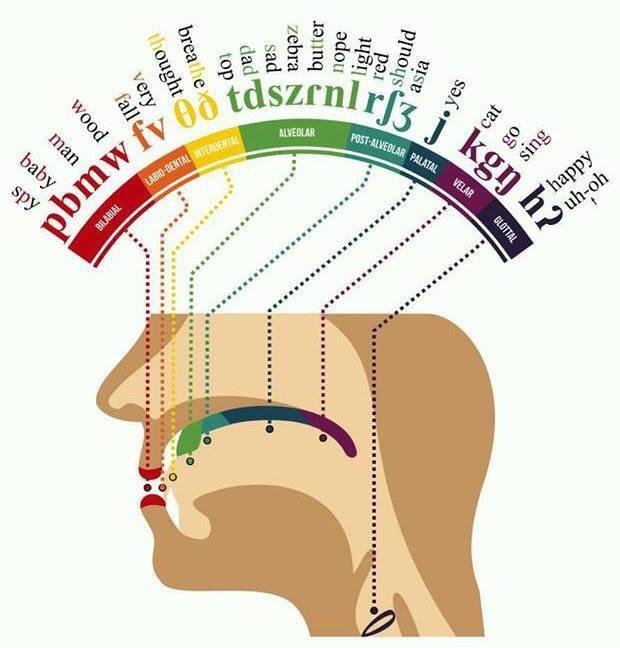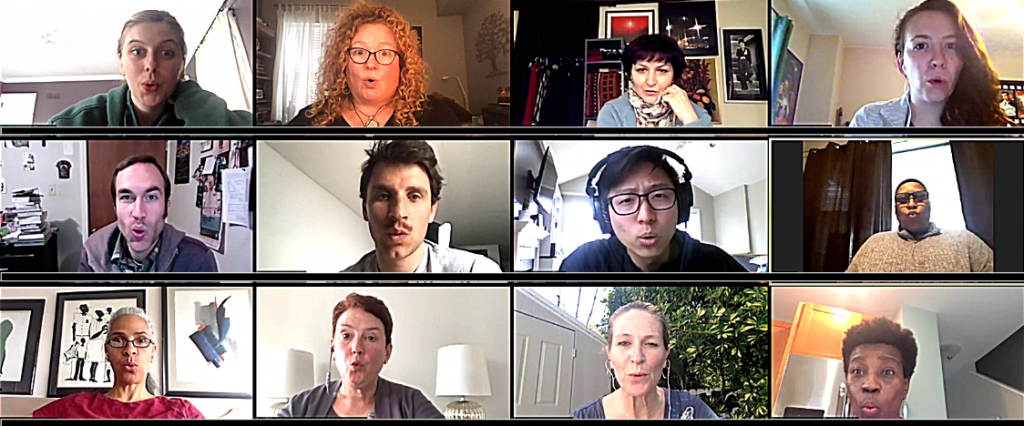Acting Studio Chicago is very fortunate to have Kate Devore as our Dialects and voice training instructor. As a voice coach and instructor, Kate has a ton of valuable information and techniques for maintaining a healthy voice. After all, it’s a huge part of our instrument as actors. Check out the information below for some incredible dialect tips and advice from Kate!
How To Be Your Own Dialect Coach
It goes without saying that the easiest way to learn an accent or dialect is to work with a professional dialect coach.

The second easiest is to purchase training materials from a reliable source (such as accenthelp.com, which I am affiliated with), created by professional coaches for you to use at home on your own.
If you’re not in a position to access those resources, you can still work up an accent on your own. Like anything else, this comes easier for some folks than it does for others! Here’s the 5-step breakdown:
1. Find good sources
The building block of learning a dialect is finding at least three different audio and/or video recordings of native speakers. This means someone whose natural dialect is the one you want (as opposed to an actor doing that accent in a performance, which may not be a reliable source).
The most comprehensive, free online resource for audio samples is The International Dialects of English Archive. It has audio samples of speakers from around the world, with helpful demographic information.
YouTube is also full of interviews with actors, politicians, pro athletes, spiritual leaders, news anchors, and tourism experts. The internet has many other resources like world radio stations, compilations of speakers for cultural preservation, and myriad other places to access speakers from a particular place.
You will also find many videos online of coaches claiming to teach an accent. Caveat emptor! Just because someone posts a video on the internet claiming to be an expert doesn’t mean they are one. ‘Nuff said.
If you want to talk with a real, live native speaker, research local Universities, restaurants, churches, cultural centers to find native speakers. People are often surprisingly happy to share their accent with you in a recorded interview.
The bottom line is, get creative and think outside the box to find real people from a given area.
2. Analyze your samples
Now that you have some good recordings of your target accent, it’s time to look under the hood. Listen several times and make notes about what jumps out at you. What do you hear? What do you feel? What do you see, even if in your mind’s eye? What tells you this speaker is from a particular place? What are they doing that is different than how you speak? What is similar?
This analysis is easier if you have a sense of what you are listening for. The basic components of a dialect are speech sounds, vocal placement, and intonation. Here’s what those terms mean:
Speech sounds are the individual spoken components of a word. For example, the word “ask” was made up of three different sounds: the vowel a, the consonant s, then the consonant k. So when analyzing a speaker, do they pronounce it as “ask”, “ahsk”, “aks”, or “ay-usk”?

Vocal placement is where it feels like the sound lives in the mouth. We create this by changing the shape of our vocal tract (the channel for sound, basically the mouth and throat). Re-shaping this pathway changes your voice. Making some key changes can affect how everything sounds because your speech is now coming out through a different filter. Is this dialect placed in the front (like Standard British/RP), or more in the back (like Russian)?
Intonation includes stress, inflection, lilt. It’s basically the music of a dialect. This is possibly the most important part, and also the hardest to master because it isn’t as rule-based as the other elements. When we listen to speakers of our own dialect, the shape of the phrase is often more important than the details. For example, if I explain something and then end by quickly saying, “Yoam sane?”, you will probably understand that I mean “Do you know what I’m saying?” Learning the melodic aspects requires listening and repeating with an ear for the inflections.
You will notice that your various speaker samples might not talk identically. This is normal, and is in your favor. There is no such thing as a monolithic accent from anywhere. You can drive 5 miles in the American South, for instance, and the dialects can change. This is good for us dialect learners!
We aren’t attempting to recreate a pre-existing Standard, we are looking for trends and themes, and coming up with a version of this dialect that is plausible. That’s a lot less pressure than trying to imitate something exactly!
Of course, there is more to mastering a dialect than just the mechanics. What does it mean to be a person who uses this dialect? Is it a point of pride for this character? Do they dislike it? What does it feel like to grow up in this place? What are some traits of people from this region? What kind of attitude do people who speak with this accent have? If the accent was a person, would it have a straight spine (as in the RP dialect), or would it slouch? Would it talk with its hands?
3. Listen and repeat
There is no substitute for practicing out loud. When in doubt, listen and repeat. You can listen to a line, hit pause, and repeat it as close to identically as possible. That can be highly effective for getting your body used to speaking in this new way. You might want to record your practice so you can assess how close you were to your mark.
You can also use a technique I call shadow speaking, which entails trying to speak along with the person at the exact same time. It reminds me of something an annoying sibling might do on a car trip. It You’ll obviously miss a lot of the words, but you can get a great feel for the intonation and placement this way.
We forget that speaking is a physical skill, but part of it really is choreography for your mouth which involves repatterining the use of dozens of muscles. As with any other motor act, there is a difference between knowing something should happen, and being physically able to do it. For example, I understand the geometry of how to sink a pool ball. But I haven’t played in so long that my muscles can no longer make that outcome happen the way I envision it. The same is true here: just because you can hear a sound change doesn’t mean your mouth can automatically do it. Hence the need for practice.
As with fight or dance choreography, you have to get the technical elements in place before you add emotion or intention. The same is often true here. You can layer your practice to start with the mechanical parts, and then add the layers of performing.
After you have the basics, practice speaking in this dialect in various situations. Talk to yourself, read from a book or article, do a monologue, have real conversations. Allow yourself the time to feel ownership of this way of speaking, so that it doesn’t feel like you’re wearing someone else’s clothes.

4. Keep it simple
If you’re staring at a dialect that seems overwhelming for the amount of time you have to prepare, keep it minimal.
Using the complete dialect convincingly is obviously Plan A. But that isn’t always possible. If you have to choose between aiming for a full version of the accent and missing the mark, or fully integrating a few key elements of the dialect that set you in the right time and place, always choose the latter.
Choose a few salient features of the accent that firmly place it in your target area. For example, if you needed a Texas dialect, without further information about specifically where in Texas, three things that might jump out as the most representative features are: 1. the hard “R’ sound; 2. the twangy vocal placement; 3. the dropping of the second half of the diphthong “eye” (as in mine, I, fire, apply) so it sounds more like the vowel “aah”.
Sometimes the intonation is the more important feature. If you’re looking at a Jamaican dialect, for instance, then the syncopated rhythm and lack of weak syllables stand out as one of those key elements.
5. Don’t panic
With some exceptions, casting directors for theatre aren’t necessarily looking for a perfect version of the accent they have in mind. They want to know that you have the ability to convincingly embody a character who speaks differently than yourself, and that you understand the essence of the accent they requested. If you give the impression that you are an actor who can handle dialects, they will trust your ability to learn the specifics over the course of rehearsals. Film and TV auditions, on the other hand, often carry the expectation that you are ready to go, unless you have the clout to request a dialect coach.
If accents come easily to you, your main work is in getting precise, specific, and natural.
If this work is more of a challenge for you, I recommend regularly spending time playing with accents and speech changes, or getting some formal training in it. That way when the time comes, your body will have the ability to authentically inhabit these new movements.
Finally, when you’re in the audition, focus on your acting above all else. The accent lives in that little part of an actor’s brain that carries technique and knows things like lines, blocking, etc. Your intentions, actions, and presence remain the most important parts of your audition.
Of course, the simplest way to be sure you make the optimal dialect choices is to hire a coach. So get in touch if you’d like to schedule a session!
Oh — one more thing. These same principles apply if you already have a foreign accent or regional American dialect and you want to sound more neutral in your spoken American English. Check out my post Can you “lose” an accent? Should you? for more specifics on that.

Kate DeVore, MA, CCC-SLP, is a voice, speech, and accent trainer, a speech pathologist specializing in professional voice, and an author. She coaches professional voice users ranging from actors to executives. Kate also teaches at the School at Steppenwolf and Columbia College Chicago and leads workshops nationally and abroad. Kate has authored, co-authored, and contributed to a number of voice, speech, and dialect self-study tools. Read more about Kate’s background and training on her site, Totalvoice, or contact her to inquire about private or group coaching.



